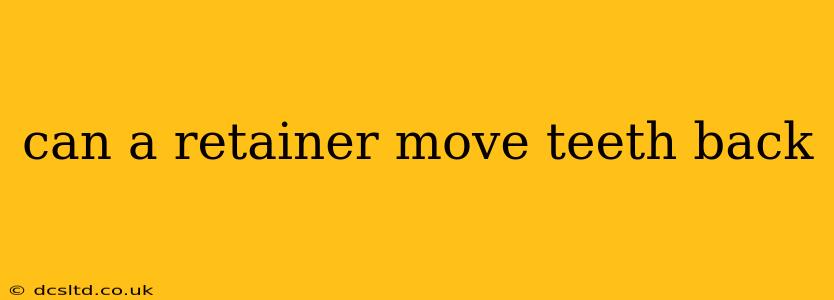Can a Retainer Move Teeth Back?
Yes, a retainer can move teeth back, but it depends on several factors. While retainers are primarily designed to maintain the position of teeth after orthodontic treatment (braces or Invisalign), certain types of retainers, and under specific circumstances, can indeed subtly reposition teeth that have shifted slightly. It's crucial to understand that retainers aren't as powerful as braces and their ability to move teeth is limited.
What Types of Retainers Can Move Teeth?
Not all retainers are created equal when it comes to repositioning teeth. The most likely candidates are:
-
Removable retainers (Hawley retainers): These retainers have a wire that sits behind the teeth and can exert some pressure. If a tooth has only recently shifted slightly, a Hawley retainer might be able to nudge it back into place, especially with the help of regular adjustments by an orthodontist. However, this is generally only effective for minor movements.
-
Fixed or bonded retainers: These are cemented to the back of the teeth and are less likely to move teeth. They primarily maintain the position of teeth and prevent relapse. While they don't actively move teeth, their presence can help prevent further shifting, indirectly assisting in maintaining the original position.
How Much Can a Retainer Move Teeth?
The amount a retainer can move teeth back is very limited. It’s generally suitable only for minor shifts, such as a few millimeters. Significant tooth movement after orthodontic treatment usually requires further intervention from an orthodontist. Trying to use a retainer to correct major misalignment is unlikely to be successful and could potentially harm your teeth and gums.
Can a Retainer Move Teeth Back on its Own?
No. While a retainer might exert enough pressure to gently shift a slightly moved tooth, it won't do so without the initial positioning and ongoing monitoring by an orthodontist. The pressure and direction of movement must be controlled to avoid further misalignment.
What if My Teeth Have Shifted Significantly?
If your teeth have shifted significantly after orthodontic treatment, you should not attempt to reposition them yourself using your retainer. Schedule an appointment with your orthodontist or dentist. They can assess the situation and recommend the most appropriate course of action, which might involve:
- Re-fitting your existing retainer: Your orthodontist might be able to adjust your retainer to help guide the teeth back into place.
- A new retainer: They may determine that a new, custom-made retainer is needed.
- Further orthodontic treatment: In cases of significant shifting, additional braces or Invisalign treatment might be necessary.
How Can I Prevent Teeth from Shifting?
To minimize the chance of your teeth shifting after orthodontic treatment, meticulous retainer wear is vital. Follow your orthodontist's instructions carefully regarding the duration and frequency of retainer wear. Regular dental checkups are also crucial for early detection of any shifting.
In summary, while a retainer might be able to subtly move teeth back under specific circumstances, significant movement requires professional intervention. Always consult your orthodontist or dentist for any concerns regarding tooth movement or retainer issues. They are best equipped to diagnose the problem and provide the most effective solution.
